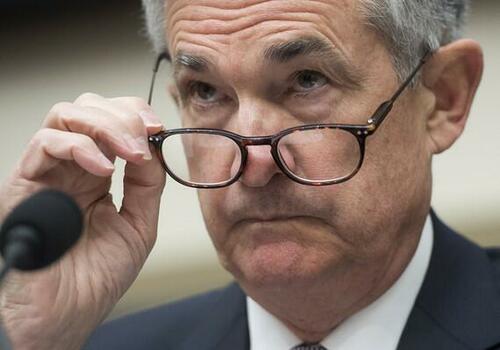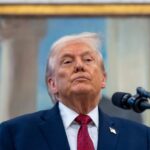
Authored by Ryan McMaken via The Mises Institute,
Last week, Jerome Powell insisted that he's not going to change his mind on allowing interest rates to rise, while allowing the assets on the Fed's portfolio to (very slowly) roll off the balance sheet. At the Federal Reserve's annual Jackson Hole conference conference, Powell's speech lasted only ten minutes. Powell had a fairly simple message. He admitted that "high inflation has continued to spread through the economy" and also admitted a single month of falling month-to-month CPI inflation is hardly enough when year-over-year CPI inflation growth continues to exceed 8 percent. He then insisted that a neutral policy stance is "not a place to pause or stop" and that the Fed would embrace "a restrictive policy stance for some time."
The Fed's idea of "restrictive" policy, of course, isn't very restrictive at all, and usually just means "less expansive than usual." Powell's speech, far from being hawkish in any meaningful sense, nonetheless signaled enough of a departure from the usual money-pumping posture to send the Dow down more than 1,000 points the same day while investors and Wall Street hacks immediately got to work complaining that the Fed wasn't going to "pivot" quickly enough.
The "pivot" narrative has long been the preferred narrative on Wall Street. Having become addicted to Fed-provided easy money-policies, Wall Street is now mostly just about cheering on monetary stimulus at the slightest sign of trouble. When the easy money flows, asset prices surge, and the markets go up. Since 2010, this has been the primary game for big investors. Keeping an eye on market fundamentals is so pre-2009. What matters now is Fed stimulus, always and forever.
Of course, once price inflation rates started coming in at multi-decade highs, even Wall Street admitted that 40-year highs in price inflation are a problem, and that the Fed will have to ease off the easy money for a little while. But the same narrative also assumes that as soon as any weakness shows up in hiring or home prices, or any other economic indicator, the fed should "pivot" to embracing easy money once again.
Many critics of the Fed's ultra-slight hawkishness, for example, expressed rage on Twitter and in financial blogs when Minneapolis Fed president Neel Kashkari said he was "happy" that markets went down in response to Powell's speech. Kashkari is desperate to be seen as doing something about price inflation, and falling markets are perhaps a sign that Powell's policies might be working. Meanwhile, Powell is being set up as a villain in a narrative in which the Fed's slight tightening will be to blame for causing an unnecessary recession when unemployment starts to rise. Many continue to believe that a recession can be avoided and—if Powell really knows what he was doing—it will be possible to get rid of price inflation without any serious economic troubles.
But this narrative gets things very wrong.
I'm not opposed to casting Powell as a villain. But Powell isn't a villain for pulling his foot a little off the money-creation accelerator. True, this is likely to speed up the arrival of the bust. But that's a sign he's actually doing something less bad than usual. No, Powell's villainy stems from his role in helping create the boom. The problem is the boom, not the bust.
After all, busts are primarily caused by the booms that come before them.
The fact that recessions are often triggered by a slowing of money creation is only a symptom of the larger problem.
Without the boom—and all the malinvestment that comes with it—investors and employers wouldn't depend on ongoing new injections of easy money to stave off a depression.
In other words, it is the boom, not the bust, for which Fed technocrats ought to be pilloried. But, we shouldn't be surprised by this confusion over what is to blame for recessions and depressions that come on the heels of booms.
In Human Action, Ludwig von Mises explains that the misinformed observers who blame the boom rather than the bust for economic misfortune. The average person "does not blame the authorities for having fostered the boom. He reviles them for the necessary collapse. In the opinion of the public, more inflation and more credit expansion are the only remedy against the evils that inflation and credit expansion have brought about."
This is exactly what we hear from Much of Wall Street right now. Mises explains, moreoever, that the bust is potentially the good part of the boom-bust cycle. It is the part of the cycle that allows the economy to return to reality, and which allows savers and investors to build the economy on a more firm foundation. The boom, contrary to its appearances, actually makes us worse off:
[W]e must call the boom retrogression and the depression progress. The boom squanders through malinvestment scarce factors of production and reduces the stock available through overconsumption; its alleged blessings are paid for by impoverishment. The depression, on the other hand, is the way back to a state of affairs in which all factors of production are employed for the best possible satisfaction of the most urgent needs of the consumers. ...
The malinvestments of the boom have misplaced inconvertible factors of production in some lines at the expense of other lines in which they were more urgently needed. There is disproportion in the allocation of nonconvertible factors to the various branches of industry. This disproportion can be remedied only by the accumulation of new capital and its employment in those branches in which it is most urgently required. This is a slow process. While it is in progress, it is impossible to utilize fully the productive capacity of some plants for which the complementary production facilities are lacking.
Phrased on modern terms, the boom creates zombie companies and zombie investments. These are activities which do not create value in a real economy, but depend on ever greater levels of cheap debt to keep kicking the can down the road. Easy money makes these bubble industries look profitable, however, so savers and investors pour money into these losing bets. Worse yet, the money poured into unprofitable bubble industries was money that would have gone to more productive, profitable, and necessary industries. Thus, bubbles slowly drain economies of productivity and value. Eventually reality catches up with these nonproductive ventures. Unless new waves of easy money keep coming, the lack of real productivity will be exposed. The economy can only be fixed when the nonproductive industries are exposed and allowed to downsize, go bankrupt, or otherwise disappear. Unfortunately, this process is painful. But, as Mises notes, it is the only way to undo the damage of the boom:
Out of the collapse of the boom there is only one way back to a state of affairs in which progressive accumulation of capital safeguards a steady improvement of material well-being: new saving must accumulate the capital goods needed for a harmonious equipment of all branches of production with the capital required. One must provide the capital goods lacking in those branches that were unduly neglected in the boom. Wage rates must drop; people must restrict their consumption temporarily until the capital wasted by malinvestment is restored. Those who dislike these hardships of the readjustment period must abstain in time from credit expansion.
Rarely is this process ever allowed to actually play out. Instead, government institutions intervene with government-created money, bailouts, and other measures. This is counterproductive:
There is no use in interfering by means of a new credit expansion with the process of readjustment. This would at best only interrupt, disturb, and prolong the curative process of the depression, if not bring about a new boom with all its inevitable consequences.
However, Mises notes the psychological effects of booms are such that people think of the booms as good fortune while the busts are where things go wrong, and whatever came immediately before the bust is assigned the blame for causing it.
We now see this at work with Jerome Powell and Fed policymakers who—driven by political expediency to seek an end to mounting price inflation—are finally and slightly backing off the monetary policy that has sustained the enormous bubbles and malinvestments that have persisted in many cases since before the 2008 financial crisis. The real causes of our presently weak economy, however, date back before the current Fed policymakers were even running the show.
Authored by Ryan McMaken via The Mises Institute,
Last week, Jerome Powell insisted that he’s not going to change his mind on allowing interest rates to rise, while allowing the assets on the Fed’s portfolio to (very slowly) roll off the balance sheet. At the Federal Reserve’s annual Jackson Hole conference conference, Powell’s speech lasted only ten minutes. Powell had a fairly simple message. He admitted that “high inflation has continued to spread through the economy” and also admitted a single month of falling month-to-month CPI inflation is hardly enough when year-over-year CPI inflation growth continues to exceed 8 percent. He then insisted that a neutral policy stance is “not a place to pause or stop” and that the Fed would embrace “a restrictive policy stance for some time.”
The Fed’s idea of “restrictive” policy, of course, isn’t very restrictive at all, and usually just means “less expansive than usual.” Powell’s speech, far from being hawkish in any meaningful sense, nonetheless signaled enough of a departure from the usual money-pumping posture to send the Dow down more than 1,000 points the same day while investors and Wall Street hacks immediately got to work complaining that the Fed wasn’t going to “pivot” quickly enough.
The “pivot” narrative has long been the preferred narrative on Wall Street. Having become addicted to Fed-provided easy money-policies, Wall Street is now mostly just about cheering on monetary stimulus at the slightest sign of trouble. When the easy money flows, asset prices surge, and the markets go up. Since 2010, this has been the primary game for big investors. Keeping an eye on market fundamentals is so pre-2009. What matters now is Fed stimulus, always and forever.
Of course, once price inflation rates started coming in at multi-decade highs, even Wall Street admitted that 40-year highs in price inflation are a problem, and that the Fed will have to ease off the easy money for a little while. But the same narrative also assumes that as soon as any weakness shows up in hiring or home prices, or any other economic indicator, the fed should “pivot” to embracing easy money once again.
Many critics of the Fed’s ultra-slight hawkishness, for example, expressed rage on Twitter and in financial blogs when Minneapolis Fed president Neel Kashkari said he was “happy” that markets went down in response to Powell’s speech. Kashkari is desperate to be seen as doing something about price inflation, and falling markets are perhaps a sign that Powell’s policies might be working. Meanwhile, Powell is being set up as a villain in a narrative in which the Fed’s slight tightening will be to blame for causing an unnecessary recession when unemployment starts to rise. Many continue to believe that a recession can be avoided and—if Powell really knows what he was doing—it will be possible to get rid of price inflation without any serious economic troubles.
But this narrative gets things very wrong.
I’m not opposed to casting Powell as a villain. But Powell isn’t a villain for pulling his foot a little off the money-creation accelerator. True, this is likely to speed up the arrival of the bust. But that’s a sign he’s actually doing something less bad than usual. No, Powell’s villainy stems from his role in helping create the boom. The problem is the boom, not the bust.
After all, busts are primarily caused by the booms that come before them.
The fact that recessions are often triggered by a slowing of money creation is only a symptom of the larger problem.
Without the boom—and all the malinvestment that comes with it—investors and employers wouldn’t depend on ongoing new injections of easy money to stave off a depression.
In other words, it is the boom, not the bust, for which Fed technocrats ought to be pilloried. But, we shouldn’t be surprised by this confusion over what is to blame for recessions and depressions that come on the heels of booms.
In Human Action, Ludwig von Mises explains that the misinformed observers who blame the boom rather than the bust for economic misfortune. The average person “does not blame the authorities for having fostered the boom. He reviles them for the necessary collapse. In the opinion of the public, more inflation and more credit expansion are the only remedy against the evils that inflation and credit expansion have brought about.”
This is exactly what we hear from Much of Wall Street right now. Mises explains, moreoever, that the bust is potentially the good part of the boom-bust cycle. It is the part of the cycle that allows the economy to return to reality, and which allows savers and investors to build the economy on a more firm foundation. The boom, contrary to its appearances, actually makes us worse off:
[W]e must call the boom retrogression and the depression progress. The boom squanders through malinvestment scarce factors of production and reduces the stock available through overconsumption; its alleged blessings are paid for by impoverishment. The depression, on the other hand, is the way back to a state of affairs in which all factors of production are employed for the best possible satisfaction of the most urgent needs of the consumers. …
The malinvestments of the boom have misplaced inconvertible factors of production in some lines at the expense of other lines in which they were more urgently needed. There is disproportion in the allocation of nonconvertible factors to the various branches of industry. This disproportion can be remedied only by the accumulation of new capital and its employment in those branches in which it is most urgently required. This is a slow process. While it is in progress, it is impossible to utilize fully the productive capacity of some plants for which the complementary production facilities are lacking.
Phrased on modern terms, the boom creates zombie companies and zombie investments. These are activities which do not create value in a real economy, but depend on ever greater levels of cheap debt to keep kicking the can down the road. Easy money makes these bubble industries look profitable, however, so savers and investors pour money into these losing bets. Worse yet, the money poured into unprofitable bubble industries was money that would have gone to more productive, profitable, and necessary industries. Thus, bubbles slowly drain economies of productivity and value. Eventually reality catches up with these nonproductive ventures. Unless new waves of easy money keep coming, the lack of real productivity will be exposed. The economy can only be fixed when the nonproductive industries are exposed and allowed to downsize, go bankrupt, or otherwise disappear. Unfortunately, this process is painful. But, as Mises notes, it is the only way to undo the damage of the boom:
Out of the collapse of the boom there is only one way back to a state of affairs in which progressive accumulation of capital safeguards a steady improvement of material well-being: new saving must accumulate the capital goods needed for a harmonious equipment of all branches of production with the capital required. One must provide the capital goods lacking in those branches that were unduly neglected in the boom. Wage rates must drop; people must restrict their consumption temporarily until the capital wasted by malinvestment is restored. Those who dislike these hardships of the readjustment period must abstain in time from credit expansion.
Rarely is this process ever allowed to actually play out. Instead, government institutions intervene with government-created money, bailouts, and other measures. This is counterproductive:
There is no use in interfering by means of a new credit expansion with the process of readjustment. This would at best only interrupt, disturb, and prolong the curative process of the depression, if not bring about a new boom with all its inevitable consequences.
However, Mises notes the psychological effects of booms are such that people think of the booms as good fortune while the busts are where things go wrong, and whatever came immediately before the bust is assigned the blame for causing it.
We now see this at work with Jerome Powell and Fed policymakers who—driven by political expediency to seek an end to mounting price inflation—are finally and slightly backing off the monetary policy that has sustained the enormous bubbles and malinvestments that have persisted in many cases since before the 2008 financial crisis. The real causes of our presently weak economy, however, date back before the current Fed policymakers were even running the show.





